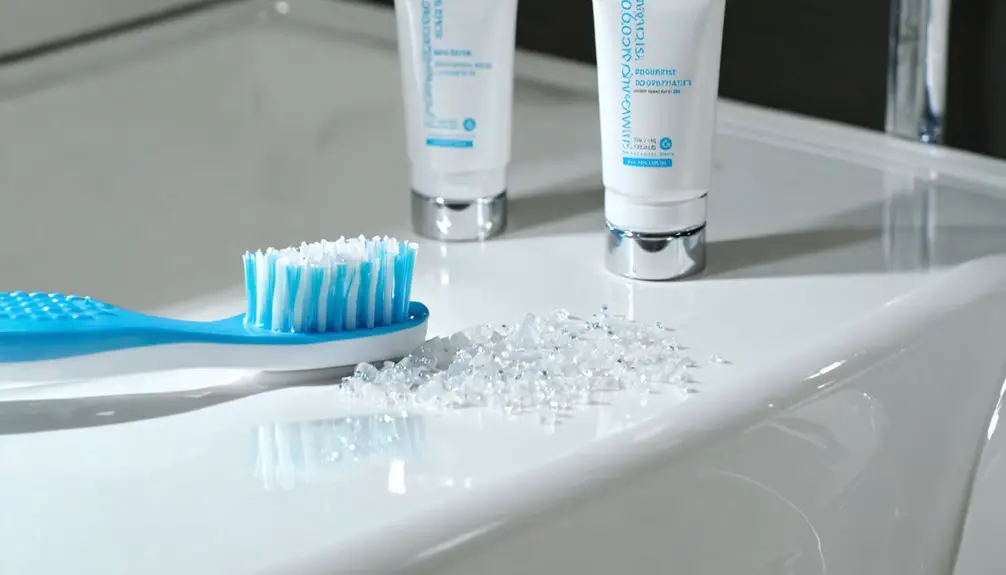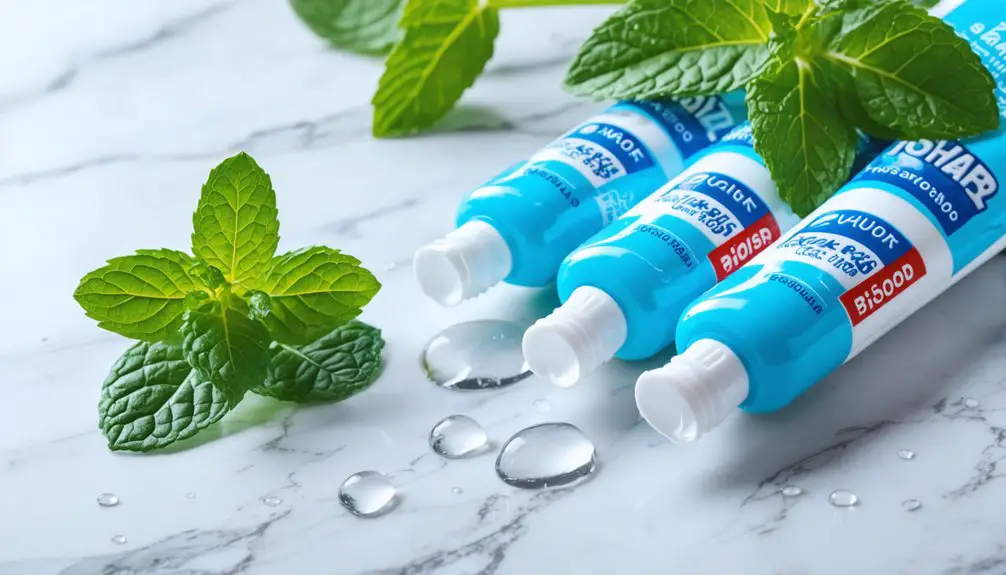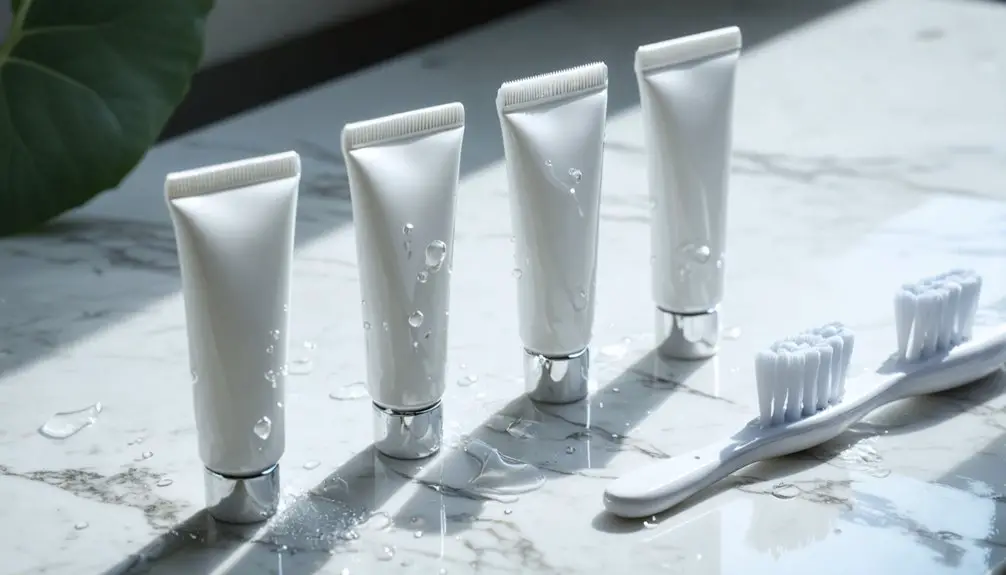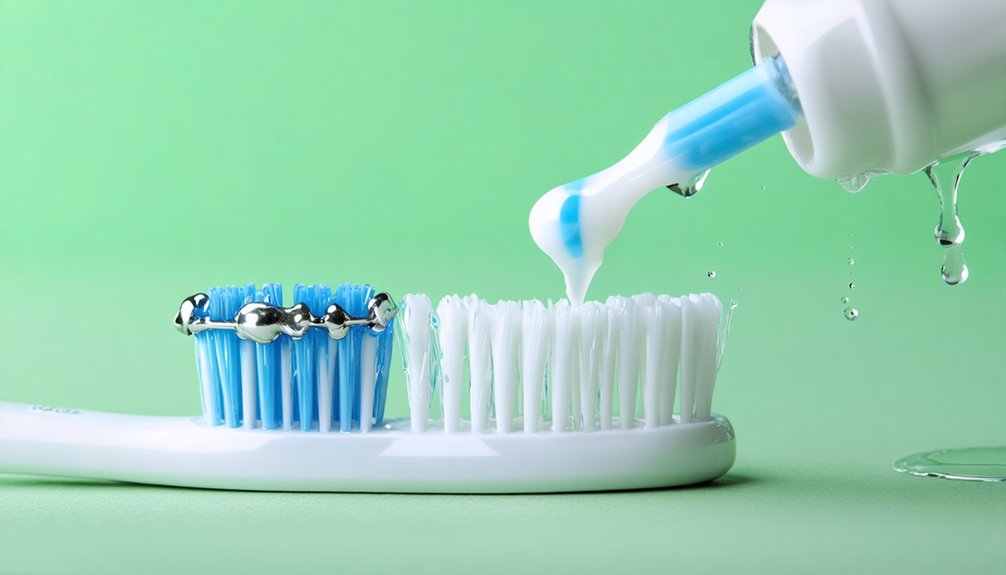For the best enamel repair while whitening, choose toothpastes containing hydroxyapatite (HAP) and fluoride, like Pronamel Clinical Enamel Strength or Ollie Clean Mint. These formulations repair up to 66% of acid-weakened enamel while gently removing stains. You’ll get ideal results by brushing twice daily for two minutes and waiting 30 minutes after acidic foods. Scientific studies confirm HAP-based toothpastes outperform traditional options for combined restoration and whitening. Understanding the specific ingredients can help you make an even more informed choice.
Key Takeaways
- Pronamel Clinical Enamel Strength repairs 66% of acid-weakened enamel while providing whitening benefits through gentle cleaning action.
- Ollie Clean Mint and Boka Ela Mint use nano-hydroxyapatite for effective enamel remineralization and natural whitening effects.
- Hydroxyapatite-based toothpastes actively rebuild enamel microstructure and create an opaque layer that improves tooth whiteness naturally.
- Stannous fluoride toothpastes like Colgate Renewal protect enamel while removing surface stains for whiter teeth.
- Tom’s of Maine and Arm & Hammer Peroxicare combine natural ingredients with peroxide for gentle whitening and enamel protection.
Understanding Tooth Enamel and Its Need for Repair
While your teeth may appear smooth and simple on the surface, tooth enamel is actually a remarkably complex biological structure composed primarily of hydroxyapatite crystals arranged in tightly packed rods.
These rods form the hardest tissue in your body, creating a protective shield for the sensitive inner layers of your teeth. However, this incredible enamel structure can’t repair itself once damaged, as it lacks living cells for regeneration.
Despite being your body’s hardest tissue, tooth enamel cannot heal or regenerate itself once damaged, making protection essential.
Your enamel health faces daily challenges from acidic foods, bacteria, and mechanical forces. The hardness of enamel measures 5 on Mohs scale, making it resistant but not indestructible to these daily threats. At its thickest points, enamel reaches a depth of 2.5 millimeters on the tooth’s working surfaces.
The protein-rich rod sheaths that help maintain enamel integrity can become compromised, leading to increased vulnerability to decay.
Understanding these limitations is essential because while enamel is exceptionally durable, it requires consistent external care to maintain its protective functions and prevent permanent damage.
Essential Ingredients That Restore Damaged Enamel
Modern toothpastes contain specific compounds that actively repair and protect damaged enamel through targeted remineralization. Hydroxyapatite, a synthetic form of natural enamel mineral, deposits directly into weakened areas and has shown superior enamel remineralization compared to traditional ingredients.
Fluoride effectiveness remains essential, as it forms decay-resistant fluorapatite while strengthening your teeth’s surface. Pronamel’s formula contains sodium fluoride that helps actively repair acid-weakened enamel.
You’ll find calcium and phosphate compounds, like CPP-ACP, working synergistically with fluoride and hydroxyapatite to enhance mineral absorption. For optimal protection, brush thoroughly twice daily with a soft-bristled toothbrush.
Potassium nitrate adds value by reducing sensitivity during the repair process.
For ideal results, look for formulations with low abrasivity and neutral pH balance.
These ingredients, combined in properly balanced formulas, create a thorough approach to enamel restoration while maintaining your teeth’s natural protective barrier.
How Whitening Agents Work With Enamel-Repair Components
The complex interplay between whitening agents and enamel-repair components reveals a carefully balanced system of chemical reactions.
The delicate balance of whitening and repair agents creates a synchronized dance of chemical processes within tooth enamel.
When whitening mechanisms begin, peroxide agents penetrate your enamel, creating free radicals that break down stain molecules. While this process effectively whitens teeth, it can temporarily soften enamel and alter mineral content. Carbamide peroxide converts to hydrogen peroxide upon contact with saliva to initiate the whitening process.
That’s where enamel-repair components step in. As whitening agents work beneath the surface, slow-release fluoride and phosphate-rich compounds actively restore mineral density. Using BioMinF toothpaste formulations, you can achieve up to six times longer protection compared to standard toothpaste. These repair elements protect against demineralization while supporting the whitening process.
The combination of tubule-occluding particles and pH balancers guarantees you’ll get the best whitening results without compromising your enamel’s structural integrity. Some formulations even include optical brighteners that work alongside chemical whitening for enhanced results.
Top-Rated Toothpastes for Combined Enamel Repair and Whitening
Several top-rated toothpastes have emerged as leaders in combining enamel repair with effective whitening capabilities.
Pronamel Clinical Enamel Strength repairs 66% of acid-weakened enamel while delivering 40% greater whitening through its dual foaming system. The formula provides 3x stronger protection compared to natural defenses against enamel wear.
For those seeking fluoride alternatives, toothpaste ingredients like nano-hydroxyapatite offer biomimetic enamel remineralization, as found in Ollie Clean Mint and Boka Ela Mint formulations. Regular use helps prevent cavities and enhances overall enamel strength.
Stannous fluoride options from Colgate Renewal and Crest Pro-Health Advanced provide extensive enamel health benefits while whitening.
You’ll find gentler approaches in Tom’s of Maine and Arm & Hammer Peroxicare, which use natural ingredients and baking soda technology respectively to protect enamel during the whitening process.
These formulations prioritize both aesthetic improvement and long-term tooth structure preservation.
Best Practices for Using Enamel-Repairing Whitening Toothpaste
Achieving ideal results with enamel-repairing whitening toothpaste requires careful attention to brushing technique and product usage. Your toothpaste selection should focus on formulas containing hydroxyapatite and fluoride while maintaining a low RDA score below 90 for minimal abrasion. Since tooth enamel cannot regenerate, it’s critical to prevent damage through proper oral care habits. Protecting enamel is essential since it contains 95% inorganic substances that give teeth their strength and durability.
Follow these essential brushing techniques to protect your enamel:
- Brush gently for two minutes twice daily, avoiding excessive pressure that can damage enamel.
- Alternate between whitening and standard fluoride toothpaste to prevent overexposure to bleaching agents.
- Wait 30 minutes after consuming acidic foods before brushing to prevent enamel softening.
Protecting Sensitive Teeth While Achieving a Brighter Smile
While proper brushing techniques protect your enamel, managing tooth sensitivity requires specific attention when pursuing a whiter smile. For effective sensitivity management, choose toothpaste containing potassium nitrate to calm nerve responses and stannous fluoride to strengthen enamel. You’ll find these ingredients in products like Sensodyne Gentle Whitening and Crest 3D White Whitening Therapy.
To optimize your whitening techniques, focus on gradual treatments rather than aggressive approaches. Use custom whitening trays with pre-applied desensitizing agents, and maintain regular dental check-ups to monitor enamel health.
You can supplement your routine with fluoride mouth rinses for added protection. If sensitivity persists, consult your dental professional to adjust your whitening regimen and rule out underlying conditions that might need attention.
Scientific Evidence Behind Enamel Restoration Products
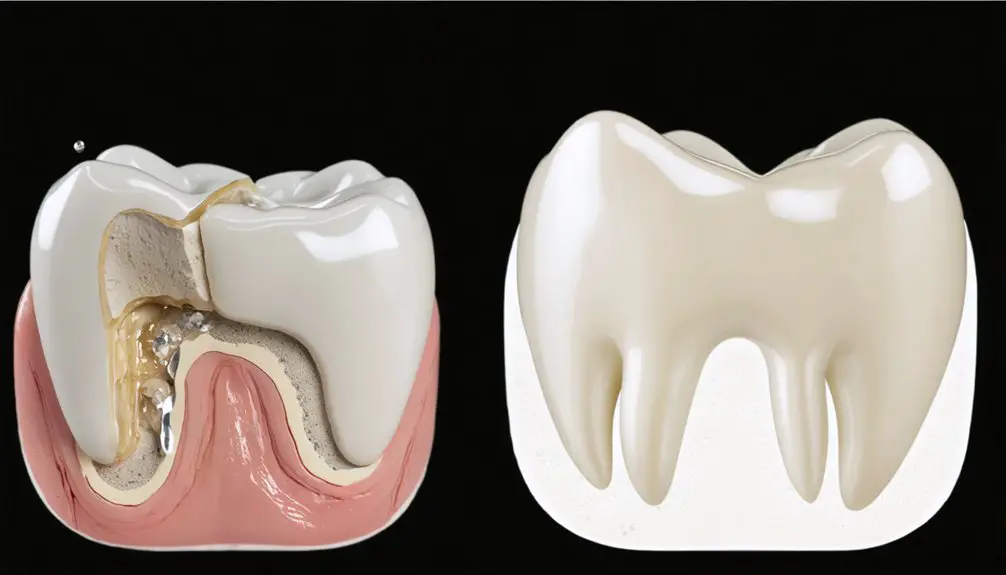
Clinical studies provide compelling evidence that hydroxyapatite-based toothpastes can effectively repair and strengthen tooth enamel through active remineralization.
You’ll find substantial research confirming that biomimetic hydroxyapatite particles fill micro-defects and restore enamel hardness, while simultaneously reducing tooth sensitivity.
Emerging research on peptide-based technologies shows promise in mimicking natural enamel formation processes, with clinical trials demonstrating improvements in both enamel restoration and whitening outcomes.
Research Validates Mineral Repair
Recent scientific research has validated the effectiveness of hydroxyapatite (HAP) in toothpaste formulations for enamel repair and remineralization.
Clinical studies show that HAP toothpaste matches or exceeds fluoride-based products in mineral absorption and enamel strength restoration, while offering reduced risk of toxicity.
Key findings demonstrate:
- Zinc-doped HAP achieves complete structural repair faster than traditional fluoride treatments.
- HAP particles bond directly to enamel surfaces, creating a protective layer that mimics natural tooth structure.
- Significant mineral restoration begins within 2 days and stabilizes by day 6 of regular use.
For those with enamel hypomineralization or sensitivity issues, HAP toothpaste provides effective management through sustained mineral delivery and retention, improving both the mechanical function and appearance of affected teeth.
Clinical Studies Show Results
Scientific evidence from multiple controlled trials has demonstrated hydroxyapatite’s superior performance in both enamel repair and tooth whitening applications.
Clinical studies show that HAP toothpaste outperforms traditional fluoride formulations in restoring enamel structure and reducing sensitivity. You’ll find that HAP works by actively rebuilding your enamel’s microstructure rather than just promoting remineralization.
Recent clinical trials evaluating experimental toothpastes containing HAP and optical colorants have yielded impressive results.
These formulations achieve whitening through a safe, non-oxidizing process by depositing an opaque HAP layer on your enamel. The studies confirm significant improvements in whiteness scores without compromising enamel integrity.
This scientific validation makes HAP-based products a compelling choice for those seeking effective enamel restoration combined with gentle whitening properties.
Frequently Asked Questions
Can Enamel-Repairing Toothpaste Reverse Existing Cavities?
You can’t achieve cavity reversal with toothpaste alone once decay forms a hole. While enamel remineralization works for early white spots, established cavities require professional dental treatment.
How Long Does It Take to See Results From Enamel-Repairing Whitening Toothpaste?
You’ll notice initial whitening in 2-4 weeks, with ideal results in 6-8 weeks of consistent use. Enamel remineralization occurs gradually alongside whitening, but you’ll need ongoing use to maintain benefits.
Are Natural Toothpastes as Effective at Repairing Enamel as Fluoride-Based Ones?
Like two skilled healers, natural hydroxyapatite and fluoride-based toothpastes both effectively repair enamel health. Studies show they’re equally capable, though hydroxyapatite offers additional benefits without fluoride’s potential risks.
Can Pregnant Women Safely Use Enamel-Repairing Whitening Toothpaste?
You’ll want to avoid whitening toothpaste during pregnancy due to safety concerns. Instead, choose ADA-approved fluoride toothpaste for enamel repair, as ingredient analysis shows uncertain risks from whitening agents.
Should Children Use Enamel-Repairing Whitening Toothpaste?
You shouldn’t give children whitening toothpaste until age 15. Focus on children’s dental health with regular fluoride toothpaste for enamel protection. Consult your pediatric dentist for safe, age-appropriate recommendations.
References
- https://www.sensodyne.com/en-gb/products/pronamel-gentle-whitening-toothpaste/
- https://www.sensodyne-me.com/en_AE/products/pronamel-intensive-enamel-repair-whitening.html
- https://crcid.com/remineralizing-teeth/
- https://www.pronamel.us/products/pronamel-intensive-enamel-repair-whitening/
- https://dailymed.nlm.nih.gov/dailymed/drugInfo.cfm?setid=a2f9d58b-671b-4427-a971-1fceff5f2323
- https://www.longdom.org/articles-pdfs/the-composition-and-functions-of-dental-enamel.pdf
- https://en.wikipedia.org/wiki/Tooth_enamel
- https://pocketdentistry.com/7-enamel-composition-formation-and-structure/
- https://pmc.ncbi.nlm.nih.gov/articles/PMC4875797/
- https://my.clevelandclinic.org/health/body/24798-tooth-enamel
